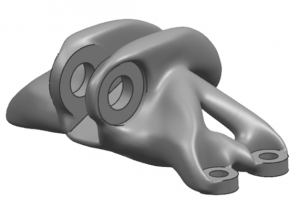Quick introduction to Topology Optimization
In this article we share our insights on how to generate new design directions with help of topology optimization.
In this article we share our insights on how to generate new design directions with help of topology optimization.
Unlike sizing- and shape optimization, structures optimized through topology optimization can attain any shape within the design space. If we take for example parts to be produced through Additive Manufacturing the possibilities are almost endless considering Additive Manufacturing does not provide restrictions on the shape of the part, the only restriction with Additive Manufacturing is the minimal wall thickness.

Optimizing parts through topology optimization without applying manufacturing constraints will result in organic looking designs (see image on the left). This is because the material will choose the shortest path from the load to the constraint, resulting in the most efficient shape mathematically. Organic results give a good understanding of the functional requirements of the part.
When the optimized part needs to be produced through conventional production methods like casting or milling, manufacturing constraints and/or symmetry patterns can be applied in order to avoid cavities and impose the desired conditions.Topology optimization is an important tool in simulation driven design.
The first step when setting up a topology optimization is the definition of the design space, this is the area used by solver for the optimization. When the solver has to perform an optimization it removes material from the design space that is not needed, it cannot add material, for this reason it is important to assign a design space that is large enough so the solver can keep removing material until it finds the best topology.
The next step in the optimization setup is the application of geometric restrictions. A geometric restriction places restrictions on the changes that the solver can make to the topology, this can be interpreted as the areas that are not allowed to change during the optimization process. In technical terms these regions are called the frozen regions. During the optimization the solver will leave these regions as they are while extracting surrounding material to find the best topology.
An also important step is the determination of the optimization objective. This step defines what we want to achieve with the optimization. Most of the time with topology optimizations it is the case that we want to maximize the stiffness while minimizing the volume of the model. The increased stiffness is achieved by minimizing the strain energy in the model. It is also possible to optimize towards other objectives such as certain Eigenfrequencies or local displacements.
The software used by Femto engineers for topology optimizations is Altair Optistruct and Simcenter 3D. During the early stages of conceptual design, topology optimization with Altair Optistruct can provide valuable insight and new ideas. The solver optimizes for maximum stiffness, specific deformations, Eigen frequencies and many other parameters. This is done by defining a design space from which the solver can remove material until the most optimal shape is achieved. Altair Optistruct is an established player with a long track record of user focused upgrades, which makes the software very suitable for fast and easy topology optimization.
Using the power of topology optimization, Femto engineers were able to achieve a 20% more cost efficient M-Frigates Radar mast design for DMO. You can read more about the DMO case study here. If you are interest in our product optimization services or need advice on methods, tools and procedures, we’d like to hear from you!
Do you need more information or want to discuss your project? Reach out to us anytime and we’ll happily answer your questions.
At Femto Engineering we help companies achieve their innovation ambitions with engineering consultancy, software, and R&D.
We are Siemens DISW Expert Partner for Simcenter Femap, Simcenter 3D, Simcenter Amesim, Simcenter STAR-CCM+ and SDC verifier. Get in touch and let us make CAE work for you.
Sign up for our newsletter to get free resources, news and updates monthly in your inbox. Share in our expertise!